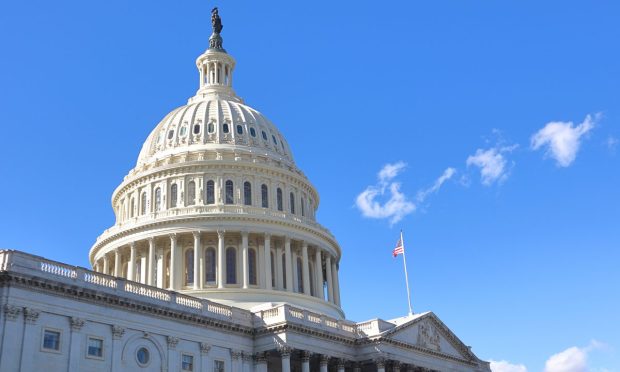Powell, Yellen Clash Over Stablecoin Regulation at Senate Hearing

Sitting next to Treasury Secretary Janet Yellen in a Senate hearing on Tuesday (Nov. 30), Federal Reserve Chairman Jerome Powell challenged her on stablecoin regulation, calling the Treasury Department’s recent recommendation that only federally insured banks be allowed to issue them “perplexing.”
Powell, an appointee of former President Donald Trump, took the side of several other Republicans in this regard, notably Sen. Pat Toomey (R-PA) and Sen. Cynthia Lummis (R-WY).
Sen. Lummis called a Nov. 1 recommendation by the President’s Working Group on Financial Markets that stablecoins be issued only by insured depository institutions — banks and savings associations — “misguided and wrong.”
The Yellen-chaired Working Group’s report called on congress to pass legislation to “ensure that payment stablecoins are subject to appropriate federal prudential oversight on a consistent and comprehensive basis.”
To do this, it recommended that new “legislation should require stablecoin issuers to be insured depository institutions, which are subject to appropriate supervision and regulation.”
Speaking before the Senate Banking Committee on Tuesday, Yellen pointed to the report’s concern that there are “significant risks associated with these currencies, risks to the payment system, risks of runs and risks related to the concentration of economic power.”
A regulatory framework including the federally chartered bank-issuer requirement would not only protect consumers, it would put stablecoins “on a level playing field with other providers of similar services, such as banks.”
That would make things much tougher on private stablecoin issuers. Not all are bothered; Jeremy Allaire, CEO of USD Coin (USDC) stablecoin issuer Circle, has been very clear that his company intends to become a national bank.
USDC is the second largest stablecoin, with a market capitalization of nearly $39 billion.
Earlier this year, Allaire told PYMNTS’ Karen Webster in an interview that guidance by the Office of the Comptroller of the Currency allowing regulated financial institutions to use stablecoins would bring the cryptocurrency further into the mainstream.
Along with an earlier Working Group report that said “dollar-backed stablecoins have the potential to improve efficiencies, increase competition, lower costs and foster broader financial inclusion,” Allaire said the letter was a “one-two punch” for the industry that “speaks to the need for banks and other financial institutions to try and participate in standards.”
Going Subprime
Earlier in the hearing, Yellen had compared the forthcoming regulation of stablecoins to that of the 2007-2010 subprime mortgage financial crisis.
At the time, she said, “financial regulators pushed to weaken safeguards, saying that a cloud of legal uncertainty hung over the derivatives markets and regulations [which] could discourage innovation and growth and drive transactions offshore. Later, the banking lobby argue that regulating subprime mortgages would decrease borrower to an reduce access to capital.”
Yellen drew a parallel to the current discussion about stablecoin regulation, saying, “it looks, again, like the financial industry uses the same arguments for stablecoins and decentralized finance platforms. All of us on this committee and both parties should be concerned about that and understand the historical parallels and listen to this very bipartisan panel.”
Rewarding Big Banks
However, Powell took exception, jumping back to the issue after answering an unrelated question.
“What is perplexing is the Working Group recommendation that all stablecoins be required to be issued by depository institutions only,” he said. “Yet as you know, the mechanism by which the value of the coin [is kept stable] vary significantly. Why suggest they all must be regulated the same way and treated as depository institutions?”
That matched the comments made by Sen. Lummis when the report was released.
Agreeing the stabecoin legislation was needed to ensure there is “prudential risk management,” Sen. Lummis had argued that stablecoins should be backed by 100% cash.
“However, proposing that only insured depository institutions may issue a stablecoin is misguided and wrong,” she said. “As of now, it’s not even clear that FDIC insurance is available for stablecoins. There are other, safer ways of achieving the same objectives.”
Among these are requiring all stablecoin reserves be maintained off-balance sheet, or held at a Federal Reserve bank, noting that “Wyoming’s special purpose depository institutions are already doing this.”
Lummis also framed the argument as a fight against the power of big finance, saying the Working Group’s recommendation would “only serve to benefit big banks and will restrict innovation.”
She added, “We should all be able to agree that startups should have the same chance as Wall Street institutions to succeed.”
Sen. Toomey took a different path, noting that not all stablecoins maintain their level price — generally one-to-one with the U.S. dollar or other currencies like the euro — by holding baskets of cash.
“The mechanism by which the value of the stablecoin is maintained relative to a fiat currency may vary significantly,” he said.
Algorithmic stablecoins, for example, use smart contracts to automatically issue more tokens if the price rises above the $1 mark, or buy and burn them when the price falls below the peg. Crypto-backed stablecoins like DAI use cryptocurrency deposited by buyers when new tokens are minted as reserve collateral. But the reserve must be over-collateralized to protect against price crashes by the collateral cryptocurrency. Generally they are several times as large as the supply of stablecoins.
Some stablecoins “arguably look somewhat like depository institutions,” he said. “Others look much more like money market accounts. Still others look like something wholly new. Why suggest that they all must be regulated the same way and treated as a depository institution?”
